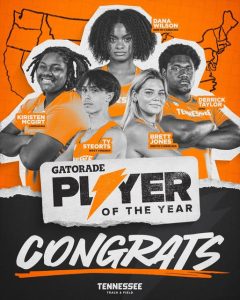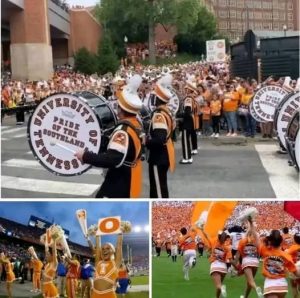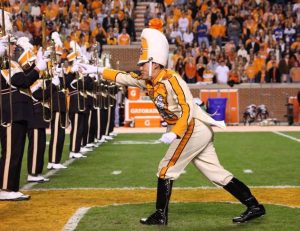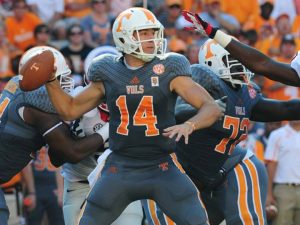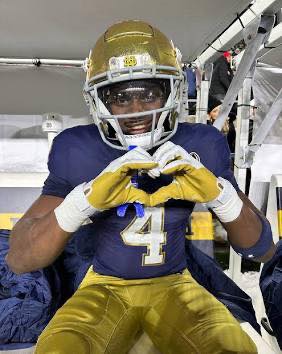
By now, anyone paying even the slightest attention to college football knows the name Jeremiah Love. After a freshman campaign that hinted at greatness and a sophomore offseason full of hype, the Notre Dame running back has exploded into the national spotlight. Some already call him the best running back in college football. And with his elite burst, vision, and top-end speed, Love is widely viewed as a legitimate Heisman Trophy contender for the 2025 season.
But as the hype train picks up speed, a question looms — one that can’t be ignored by even the most diehard Fighting Irish fans: Will Jeremiah Love get enough touches to actually win the Heisman? Talent alone isn’t enough. The Heisman requires volume, opportunity, and often, an offensive philosophy tailored to showcase the candidate. And for Love, that’s far from a guarantee in South Bend.
The Talent is Undeniable
Let’s be clear: Jeremiah Love is special.
Listed at 6-foot-1, 205 pounds, Love possesses a rare combination of size and track-star speed. He clocked sub-10.7 in the 100 meters in high school, and that explosiveness shows every time he hits the second level. Defenders rarely catch him from behind. But unlike many speed backs, Love doesn’t shy away from contact. He runs with surprising strength, rarely goes down on first contact, and has the ability to break arm tackles with ease.
Love also brings elite vision to the field — he has a natural feel for when to cut, when to bounce it outside, and when to put his foot in the ground and get north. He’s scheme versatile, capable of thriving in zone or gap systems, and perhaps most importantly in today’s game, he’s a weapon in the passing game. Whether it’s swing passes, wheel routes, or screens, he’s dangerous with the ball in space.
He’s not just one of the most explosive backs in the country — he’s one of the most complete.
The Heisman Resume Requires Volume
Despite all that talent, the biggest hurdle Love faces isn’t his competition — it’s his usage.
To win the Heisman as a running back, history shows you need two things: elite production and sustained national exposure. The last running back to win the award was Alabama’s Derrick Henry in 2015, who posted a staggering 395 carries for 2,219 yards and 28 touchdowns. That’s over 30 carries per game. Even when Mark Ingram won it in 2009, he logged 271 carries and over 1,600 rushing yards — with an additional 334 receiving.
In today’s pass-heavy landscape, a running back simply must dominate touches to enter the conversation. That means 20+ carries per game, being the clear RB1, and staying on the field in every big moment. And that’s where the concern lies for Jeremiah Love.
Notre Dame has depth at the running back position, and Marcus Freeman — now entering a critical year in his tenure — may not want to overwork any single back. While understandable from a program standpoint, it could come at the cost of Love’s Heisman aspirations.
Sharing the Load: Notre Dame’s Crowded Backfield
Notre Dame’s running back room is deep, talented, and experienced. Jadarian Price is back and healthy. Gi’Bran Payne has shown flashes. And there’s always the possibility of younger backs earning carries in garbage time or certain packages. Add in the presence of a dual-threat quarterback like Riley Leonard, and it becomes even murkier.
In 2024, Love split carries with Audric Estimé and the rest of the backfield, finishing with just 104 carries. While he averaged an eye-popping 6.5 yards per carry, his usage was inconsistent. There were games where he looked like the clear best option but was curiously underutilized — a theme that frustrated fans and analysts alike.
Now with Estimé gone to the NFL, the path is clear for Love to become the lead back. But “lead back” can mean a lot of things. In some offenses, it means 18-25 touches per game. In others, it means 12 carries and a shared workload.
If Notre Dame wants to maximize Love’s Heisman potential — and showcase their most explosive offensive weapon — he needs to be treated like a bell cow. That means 18–22 carries minimum per game and consistent involvement in the passing game. Anything less, and he risks becoming yet another “what if” talent in the Heisman discussion.
New OC Mike Denbrock Must Make a Statement
Notre Dame brought in offensive coordinator Mike Denbrock to reinvigorate a stagnant offense, and his track record suggests he could be the key to unlocking Love’s full potential. Denbrock helped turn LSU into an offensive juggernaut under Brian Kelly, most recently helping Jayden Daniels win the 2023 Heisman.
But here’s the catch: Denbrock’s LSU offense was built around a quarterback. Daniels threw for over 3,800 yards and ran for over 1,200. He was the centerpiece of everything. Will Denbrock adjust his scheme in South Bend to feature a running back as the focal point?
So far, the signals have been mixed. While spring practices showed a heavy dose of run plays and an effort to get Love the ball in space, Denbrock has also spoken glowingly about quarterback Riley Leonard and the need to create a balanced attack. Love has to be the primary weapon — not just a part of the offense. Notre Dame doesn’t need balance if it comes at the cost of feeding their best player.
The Path to the Heisman is Narrow — But Doable
Let’s paint a realistic Heisman path for Love.
If Notre Dame wants to elevate him into the elite tier of college football stardom, here’s what likely needs to happen:
- 1,800+ total yards (rushing + receiving) – This can include 1,500+ rushing and 300+ receiving.
- 20+ total touchdowns – Preferably with multiple big moments in prime-time games.
- Dominant performances in big games – That means breaking off long runs vs. USC, LSU, and Texas A&M.
- Consistent volume – 18-22 carries per game, with at least 3-4 targets in the passing game.
Anything less, and Love likely won’t have the numbers to compete with quarterbacks who’ll throw 30+ touchdowns and generate weekly highlight reels.
The truth is that the Heisman often comes down to narrative and momentum. Love has the talent. He just needs the volume to back it up.
Notre Dame’s National Schedule Helps — If Love Is Featured
One advantage working in Love’s favor is Notre Dame’s schedule. The Irish have high-profile games against Texas A&M (week 1), USC, Florida State, and Georgia Tech — all of which will be televised nationally and scrutinized by voters.
A signature moment — say, a 200-yard performance against a ranked Texas A&M team on opening weekend — could immediately vault Love into the spotlight. But again, that only happens if he gets the touches.
Too often, Heisman-caliber backs are buried behind committee workloads. Last year, Michigan’s Blake Corum was viewed as a contender early but ultimately faded from the conversation due to modest numbers and a shared backfield. Notre Dame and Mike Denbrock must avoid that trap.
What Jeremiah Love Brings Beyond the Stats
Love’s impact goes beyond the box score. His presence on the field forces defenses to account for the run on every down. He makes life easier for the quarterback. He opens up play-action. And he’s a threat to score every time he touches the ball. That kind of game-breaking ability needs to be unleashed — not contained in a rotation.
If Notre Dame wants to get over the hump and compete in the College Football Playoff, Love has to be a foundational piece — not a situational one. The team’s ceiling rises exponentially when he’s getting 25 touches.
And for Love personally, this season is pivotal. A monster year not only makes him a Heisman finalist but also cements him as a first-round NFL Draft prospect. The stakes couldn’t be higher.
Final Thoughts: Treat Him Like a Superstar
Notre Dame has a Heisman contender in its backfield. Not a potential one. Not a dark horse. A legit, top-tier candidate who can carry an offense and electrify a fanbase. But it only works if he’s given the chance.
Jeremiah Love must be treated like what he is — the best running back in college football.
No more split carries in crucial drives. No more limiting his touches to keep him fresh. Notre Dame has a generational talent, and it’s time to unleash him.
If Marcus Freeman and Mike Denbrock truly want to compete for a national title — and possibly produce the first Notre Dame Heisman winner since Tim Brown in 1987 — it starts with giving #12 the rock.
